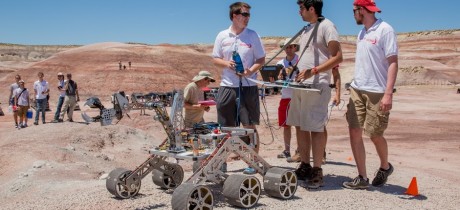Know someone who is passionate about exploring Mars but is still in college? How can they help create the next generation of robotic explorers?
Since 2007, a unique competition held in Utah each summer encourages students from around the world to design and build their own Mars rovers.
Photo credit: Cassandra Klos | The Mars Society
Between June 1-3 this year, The University Rover Challenge (URC) will gather as it has in past years near Hanksville, Utah at the Mars Desert Research Station. This station is a full-scale analog facility that supports research for human space exploration in the essential areas of technology, operations and science.
Among many requirements and guidelines, the competition requires that the rover built by university students be a stand-alone, off-the-grid, mobile platform. The rovers will have to be operated from designated command and control stations where the operators will not be able to see the course.
Last year, 63 teams from twelve countries were featured! This included more than 300 college students and 28 rovers.
Having grown into one of the world’s largest robotics competitions, the URC is successful through the passion of their increasing number of student participants. There are four competition tasks that will be used to judge the rover.
The Science Cache task has a goal of collecting samples from a selected site in the field, performing basic science evaluation of the samples with instrumentation that is onboard the rover, and store at least one sample in a cache for further scientific analysis. Sound familiar? NASA’s Mars 2020 rover will also collect and cache carefully selected samples of Mars rock and soil for possible return to Earth.
The same task also requires the site(s) to be analyzed for their likelihood to support microbial life. The geologic context, such as evidence of water flow, minerals present and soil structure will be used to determine the likelihood of microbial life.
Another component of URC is the Extreme Retrieval and Delivery Task which will require rovers to retrieve and deliver objects in the field. While accomplishing this and assisting astronauts, the rover would be traversing a wide variety of terrain that could include soft sandy areas, rough stony areas, rock and boulder fields, and vertical drops more than half a meter in addition to encountering steep slopes more than 45 degrees.
The Equipment Servicing Task will require that the rover operate in a mock-up equipment system. Finally, for the Autonomous Navigation Task, rovers will need to autonomously traverse between gates across difficult terrain.
Held annually, the URC is a project of an international non-profit humans to Mars organization, The Mars Society. Also part of the URC are the European Rover Challenge and United Kingdom University Rover Challenge events.
Learn more about the Challenge at the Mars Society website.



